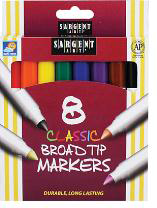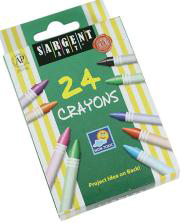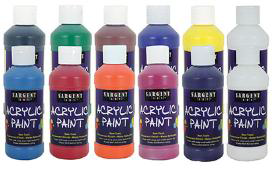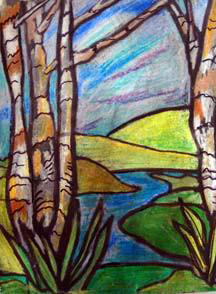The art of stained glass windows arose in Europe some time before the year 1000 and enjoyed a magnificent development throughout the Middle Ages. Contemporary artists such as Louis Comfort Tiffany propelled the popularity of stained glass to new heights during the late 19th and 20th centuries. These artworks were a culmination of years of experimentation that saw the development of a special type of glass and a variety of surface textures as well as the introduction of vibrant colors.
Goal (Terminal Objective):
Students will define stained glass as an architectural element with historical importance.
Objective:
Students will understand the historical significance of the stained glass window in historical and contemporary architecture.
Students will contrast transparent and translucent exemplars.
Students will define radial balance and identify examples.
Students will create a stained glass design drawing in the style of Louis Comfort Tiffany.
National Standards:
Visual Arts Grades 5-8 Content Standard 1: Understanding and applying media, techniques, and processes
Visual Arts Grades 5-8 Content Standard 3: Choosing and evaluating a range of subject matter, symbols, and ideas
Visual Arts Grades 5-8 Content Standard 5: Reflecting upon and assessing the characteristics and merits of their work and the work of others
Social Studies Cross Curriculum Connection
Purpose:
Historical and contemporary exemplars of stained glass windows are studied, focusing on purposes, design qualities and the distinction between translucent and transparent color. Radial design and landscape design will be studied. Students will become aware of variations of media, techniques, and processes used to investigate pattern in an artwork. Students will become familiar the historical development of the use of stained glass windows in architecture.
New Vocabulary:
stained glass, transparent, translucent, lead line, radial balance, asymmetrical balance, symmetrical balance, light source, simplification, analogous
Materials:

#22-1530 Classic Broad Tip Markers

#55-0924 Standard Size Economy Crayons Peggable Box

#22-2399 Acrylic Paint

#22-8808 Acrylic Gloss & Varnish

#22-8815 Acrylic Matte Medium
heavy white paper
Time:
This lesson may be modified from one to three hours, depending upon the size and complexity of expectations.
Introduction and Motivation (Set):
Display exemplars of stained glass artwork. Include the work of Louis Comfort Tiffany, Marc Chagall, and Henri Matisse.
Discuss exemplars from Gothic Cathedrals; include an exemplar of a rose window. Discuss where students might have seen examples of stained glass windows.
Ask students to compare the distinct differences between real stained glass and plastic exemplars. Explain that real stained glass is made of pieces of colored glass held together with strips of lead. The lead is soldered over the glass to keep it in place.
Usually, over a period of time this leaded boarder turns black.
Provide examples of transparent and translucent glass. Explain that transparent can be seen through while translucent means light glows through it.
View examples of rose windows and discuss radial balance.
View examples of stained glass art of Louis Comfort Tiffany and discuss his use of symmetrical and asymmetrical balance in landscape design.
Instruction:
Teacher will provide student exemplar of student product.
Teacher will demonstrate planning a landscape stained glass landscape window in the style of Tiffany using simplification of design.
Guide students to distinguish between symmetrical and asymmetrical composition. Discuss with students the importance of creating linear boarders to replicate the lead lines in a stained glass window.
Discuss the color wheel and identify analogous colors. Demonstrate coloring negative space areas with analogous colors.
Activities:
(1) Guided Practice:
- Students generate sketches for their stained glass landscape.

- Students will select sketch for final project and go over pencil sketch lines with a dark marker.

- Using crayons, students will begin coloring the negative spaces between the marker lines. Students will color each area in analogous colors, ie. for leaves or grass use green yellow, yellow- green, and dark green.

- Students apply color to all areas created by the marker border. Do not use crayon on the marker border.



- After all areas are colored with crayons, go over all a small area at a time with a thin black acrylic wash, wiping off with clean cotton pad, and polishing to a sheen. Acrylic paint will seep into the marker line causing a darker border to simulate the lead lines in a stained glass window.Students will coat finished project with Sargent gloss acrylic or matte glaze.

- Students will compose a writing component describing, in depth, the emotion portrayed and the innovations they provided to their piece.
(2) Independent Practice and Check for Understanding:
Teacher circulates among working students visually recording students demonstrating understanding of objectives and provides reinforcement.
(3) Closure:
Students record the steps taken to simplify their sketches. Students will include innovations they provided to the piece.
Evaluation:
Level One — The finished stained glass artwork very successfully demonstrates the student’s understanding of simplification to stylize a landscape in the style of Louis Comfort Tiffany. The student was able to articulate examples of stained glass used in history as well as list three contemporary artists who were known for their stained glass artworks. The student successfully provides examples of radial design as used in stained glass art. The student has correctly defined translucent and transparent. The student has shown a high level of craftsmanship and technical skill while including at least three analogous colors in the segments of the stained glass design. The student successfully completed the writing component describing, in depth, the characteristics of stained glass and the differences between their artwork and an actual piece of stained glass art.
Level Two — The finished stained glass artwork successfully demonstrates the student’s understanding of simplification to stylize a landscape in the style of Louis Comfort Tiffany. The student was able to articulate examples of stained glass used in history as well as list two contemporary artists who were known for their stained glass artworks. The student successfully provides one example of radial design as used in stained glass art. The student has correctly defined translucent and transparent. The student has shown a good level of craftsmanship and technical skill while including at least three analogous colors in the segments of the stained glass design. The student successfully completed the writing component describing, in depth, the characteristics of stained glass.
Level Three — The finished stained glass artwork demonstrates the student’s understanding of simplification to stylize a landscape in the style of Louis Comfort
Tiffany. The student was able to articulate examples of stained glass used in history as well as list one contemporary artists who were known for their stained glass artworks. The student successfully provides one example of radial design as used in stained glass art. The student has made an attempt to define translucent and transparent. The student has shown some level of craftsmanship and technical skill. The student has made an attempt to complete the writing component.
Level Four — The finished stained glass artwork somewhat demonstrates the student’s understanding of simplification to stylize a landscape in the style of Louis Comfort Tiffany. The student was not able to articulate examples of stained glass used in history. The student successfully could not provide one example of radial design as used in stained glass art. The student has made an attempt to define translucent and transparent. The student has shown poor craftsmanship and technical skill. The student has not made an attempt to complete the writing component.
Extension:
Students may use mat knives to cut their design into black construction paper and glue tissue in the spaces left by the cutting.
Invite a local stained glass artist to visit the classroom. After viewing the process of a professional stained glass artist, ask students to compare the professional art work with their classroom project.
Resources:
http://en.wikipedia.org/wiki/Stained_glass
http://www.thestorefinder.com/glass/library/history.html
http://en.wikipedia.org/wiki/Marc_Chagall
http://www.un.org/cyberschoolbus/untour/subcha.htm
http://en.wikipedia.org/wiki/Louis_Comfort_Tiffany
http://www.metmuseum.org/explore/tiffany/listsgw.htm
http://www.artlex.com/ArtLex/s/stainedglass.html
http://en.wikipedia.org/wiki/Chapelle_du_Saint-Marie_du_Rosaire
Art Consultant



